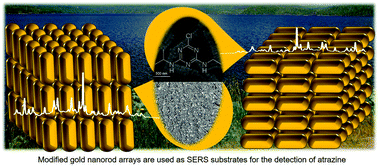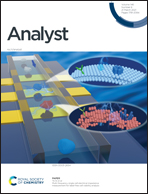Optimization of gold nanorod arrays for surface enhanced Raman spectroscopy (SERS) detection of atrazine†
Abstract
Recently, there has been increasing concern over the widespread use of the herbicide atrazine which has been reported to have problematic side effects on local ecosystems. This has highlighted the need for rapid and accurate point-of-need assessment tools for analytical determination of herbicides in ground and surface waters. Surface enhanced Raman spectroscopy (SERS) is a sensitive vibrational spectroscopy technique which has recently been employed for the analysis of a variety of analytes in water, ranging from pharmaceuticals to pesticides. In this work, SERS sensors constructed using gold nanorod (AuNR) arrays are optimized and then utilized for the rapid and sensitive detection of atrazine. In this study, the effect of relative humidity on the self-assembly of gold nanorods into arrays was explored, and the SERS performance was assessed using para-aminothiophenol as a SERS probe. Once the SERS performance of the substrates was deemed optimal, the detection of atrazine was highlighted. This work represents the first time that relative humidity has been explored as an optimization strategy for controlled alignment of gold nanorods for SERS analysis of atrazine.

- This article is part of the themed collection: 150th Anniversary Collection: Raman Spectroscopy and SERS


 Please wait while we load your content...
Please wait while we load your content...